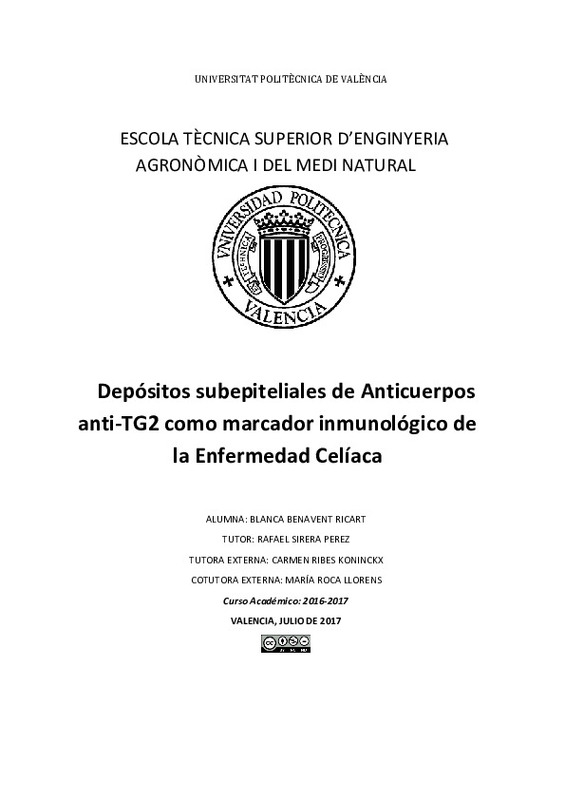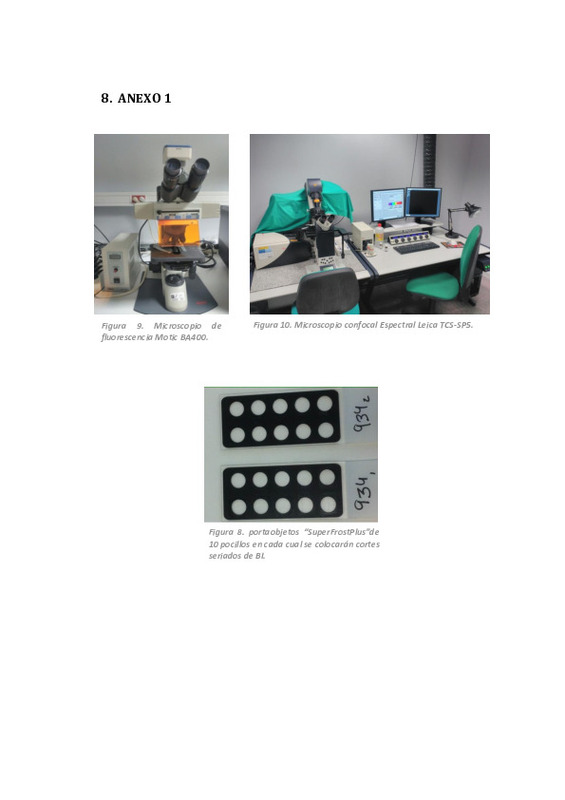|
Resumen:
|
[ES] La enfermedad celíaca (EC) es una alteración sistémica de carácter autoinmune
desencadenada por el consumo de gluten y prolaminas relacionadas, en individuos con
predisposición genética caracterizada por una combinación ...[+]
[ES] La enfermedad celíaca (EC) es una alteración sistémica de carácter autoinmune
desencadenada por el consumo de gluten y prolaminas relacionadas, en individuos con
predisposición genética caracterizada por una combinación variable de manifestaciones
clínicas gluten-dependientes, anticuerpos específicos de EC, haplotipo HLA DQ2 y DQ8 y
enteropatía. Se caracteriza por cambios histológicos a nivel de la mucosa del intestino delgado
como atrofia vellositaria o hiperplasia de las criptas y provoca la secreción de autoanticuerpos
dirigidos contra la transglutaminasa tisular de tipo 2 (TG2).
Actualmente el diagnóstico de EC se establece en base a 4 condiciones: la clínica o
sintomatología del paciente, cambios y alteraciones a nivel de la mucosa intestinal, serología y
HLA. Ante valores altos de autoanticuerpos, el diagnóstico en niños y adolescentes se puede
realizar sin necesidad de biopsia intestinal (BI), apoyado en unos criterios estrictos que
incluyen la positividad de anticuerpos anti-transglutaminasa tisular de tipo 2 (anti-TG2) y
anticuerpos anti-endomisio (EMA) en el estudio serológico, según los nuevos criterios de la
ESPHGAN 2012.
Las manifestaciones de la EC pueden variar desde formas clínicas a formas histológicas y
serológicas, que en ocasiones pueden dificultar el diagnóstico: formas asintomáticas, una
mucosa duodenal con apariencia normal y/o marcadores serológicos negativos. Así pues, en
casos en los que haya dificultad para la evaluación del diagnóstico, son necesarios otros
marcadores como la presencia de depósitos subepiteliales de anticuerpos
antitransglutaminasa 2 de clase IgA (depósitos anti-TG2 IgA).
La detección de estos depósitos intestinales anti-TG2 parece ser una herramienta
diagnóstica muy específica y sensible en pacientes celíacos. Así se ha descrito que individuos
que presentan depósitos intestinales pero sin ninguna alteración histológica a nivel del
intestino, terminan desarrollando la enfermedad. Sin embargo, se necesitan nuevos estudios
que confirmen el papel como marcador predictivo en el posterior desarrollo de la EC. Para la
determinación de los depósitos anti-TG2 se realizará un estudio de inmunofluorescencia con
muestras de BI de pacientes previamente congeladas, incubándolas secuencialmente con
anticuerpo monoclonal de ratón anti TG2, anticuerpo secundario anti inmunoglobulina de
ratón conjugado con rodamina (TRICT), y posteriormente con anticuerpo policlonal de conejo
anti IgA humana conjugado con FITC. Los autoanticuerpos forman depósitos debajo de la
membrana basal epitelial y alrededor de la mucosa de los vasos sanguíneos y de las criptas y
serán detectados mediante microscopia de fluorescencia o confocal por colocalización de
anticuerpos de clase IgA (fluorescencia verde) con la TG2 (fluorescencia roja).
Los autoanticuerpos pueden ser detectados en el suero de pacientes celíacos que lleven
una dieta normal con gluten y la dinámica de su desaparición tras iniciar una dieta exenta de
gluten (DExG) varía según individuos, negativizándose tras 6 a 18 meses de dieta.
El objetivo del trabajo es evaluar el valor diagnóstico de la determinación de los depósitos
subepiteliales de la anti-transglutaminasa tisular de tipo 2 (anti-TG2) en población pediátrica
como marcador de la EC. Para ello, se incluirán pacientes de edad comprendida entre 0 y 16
años a los que se haya realizado Biopsia Intestinal y estudio de depósitos, con carácter
retrospectivo. Se analizarán los resultados de los depósitos en relación con diferentes
variables: diagnóstico final, serología (anti-TG2 IgA), predisposición genética HLA compatible y
con el grado de lesión histológica.
[-]
[EN] Celiac disease (CD) is a systemic autoimmune disorder triggered by the consumption of
gluten and related prolamins in individuals with genetic predisposition characterized by a
variable combination of gluten-dependent ...[+]
[EN] Celiac disease (CD) is a systemic autoimmune disorder triggered by the consumption of
gluten and related prolamins in individuals with genetic predisposition characterized by a
variable combination of gluten-dependent clinical manifestations, EC specific antibodies, HLA
DQ2 and DQ8 haplotypes, and Enteropathy. It is characterized by histological changes at the
mucosal level of the small intestine such as villous atrophy and/or cryptic hyperplasia and
causes secretion of autoantibodies directed against type 2 transglutaminase (TG2).
The diagnosis of CD is made based on 4 conditions: clinical symptoms, changes and
alterations at the level of the intestinal mucosa, serology and HLA. The new diagnostic criteria
of ESPHGAN 2012 allow skipping intestinal biopsy in children and adolescents if a number of
conditions are met.
CD manifestations may vary from clinical to histological and serological forms, which can
occasionally hinder the diagnosis: asymptomatic forms, an apparently normal duodenal
mucosa and/or negative serological markers. Thus, in cases where there is difficulty in
evaluating the diagnosis, there is a need for new markers such as the presence of subepithelial
deposits of anti-transgenic antibodies 2 of the IgA class (anti-TG2 IgA deposits).
The detection of these anti-TG2 intestinal deposits seems to be a very specific and
sensitive diagnostic tool in celiac patients, although they can also be detected in other glutenrelated
pathologies. Thus, it has been described that individuals who present intestinal
deposits but without any histological alteration at the level of the intestine, end up developing
the disease. However, further studies are needed to confirm the role of TTG dep as a
predictive marker in the further development of CD. For the determination of anti-TG2
deposits, an immunofluorescence study will be performed with IB samples from previously
frozen patients, incubating them sequentially with anti-TG2 mouse monoclonal antibody,
secondary anti-mouse immunoglobulin conjugated with rhodamine (TRICT), and subsequently
with Rabbit polyclonal anti-human IgA antibody conjugated to FITC. Autoantibodies form
deposits under the epithelial basement membrane and around the mucosa of blood vessels
and crypts and will be detected by fluorescence or confocal microscopy by colocalization of IgA
class antibodies (green fluorescence) with TG2 (red fluorescence).
Autoantibodies can also be detected in the serum of celiac patients who are on a normal
gluten diet and can be present for a longer period even if they start a gluten-free diet (GFD).
The relationship between the persistence of autoantibodies and the duration of GFD has been
studied in organ culture to assess the gluten-dynamic toxicity of their disappearance after
initiating a GFD varies by individuals, negativizing between 6 and 18 months after starting the
diet.
The aim of the present study is to evaluate the diagnostic value of the determination of
subepithelial deposits of type 2 anti-transglutaminase (anti-TG2) in the pediatric population as
a marker of CD. This will include patients aged 0-16 years who have had an Intestinal Biopsy
and a retrospective study of deposits. We will analyze the results of the deposits in relation to
different variables: final diagnosis, serology (anti-TG2 IgA), genetic predisposition HLA
compatible and the degree of histological lesion.
[-]
|








